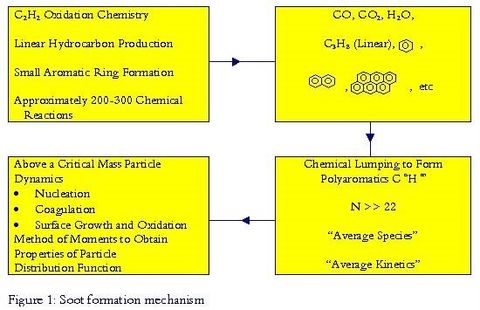SOOT MODELLING
SOOT MODELLING
The formation of soot during hydrocarbon combustion is a major problem for the oil industry and engine manufacturers. How soot is formed and what approaches can be used to minimise its formation are still unclear. A model has therefore been developed based on acetylene as the soot precursor using fundamental chemistry to describe the soot formation.
The model consists of four parts:
- In the first a chemical reaction scheme, consisting of 300 reactions and 70 species, is modelled to describe the pyrolysis of acetylene and the formation of small aromatic species up to coronene. Reaction rate constants and thermodynamic data have been obtained from the open literature or estimated based on a sound chemical knowledge of the species and reactions.
- The second stage of the model is the formation of polyaromatics as a result of successive acetylene addition to the initial smaller aromatics. The technique of chemical lumping is used here to minimise the number of equations required. This part of the model gives aromatic species containing hundreds of C-atoms.
- The third part of the model assumes that polyaromatic species above a certain artificial mass can be considered as particles and can be described by equations used to model particle dynamics. The method of moments is used to solve these equations which instead of giving detailed information about the size and number of particles describes their average properties, mean number of particles and the standard deviations from these means.
- The fourth part of the model describes the surface growth and oxidation of these particles.
The adjacent figure illustrates the scheme by which the soot particles are assumed to form. The final number of equations in the model is of the order of 400. This complex reaction scheme is readily coded using FACSIMILE’s high-level programming notation which was purpose designed for stating the problem as a chemist would describe it. The problem is then submitted to the FACSIMILE solver which copes with all the mathematical aspects of the solution using robust, proven, efficient numerical methods.
The results from this highlighted application have identified a number of important aspects of the underlying mechanisms which have led to an improved understanding of soot formation.



